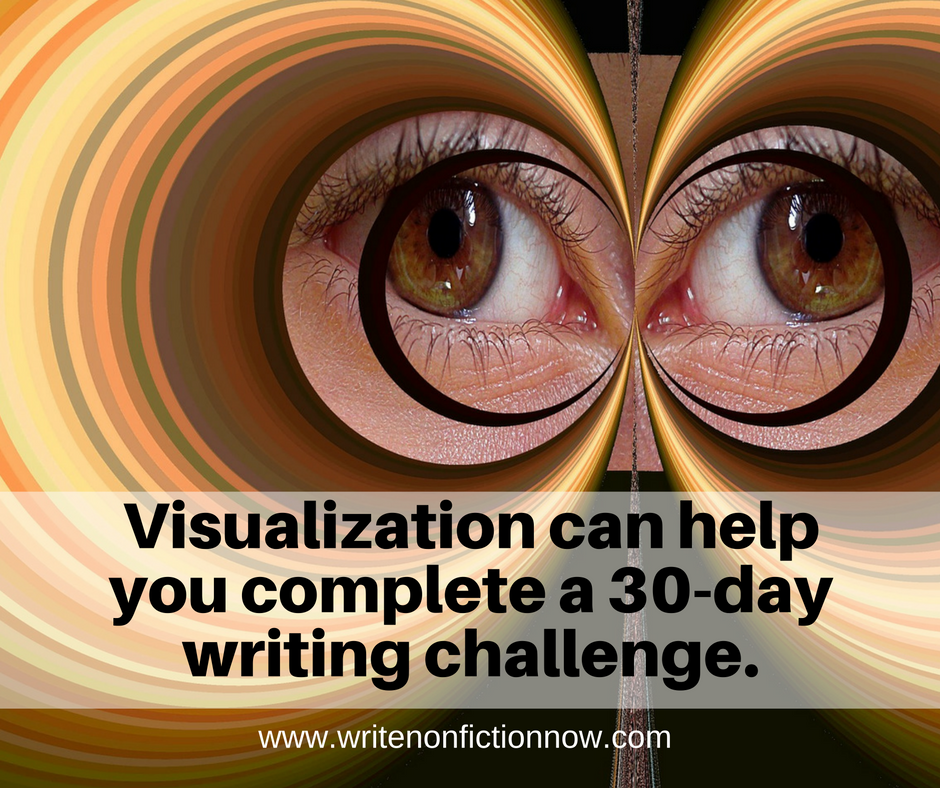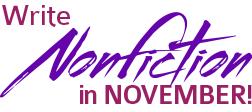
Have you tried to complete a 30-day writing project…and failed? Did you find yourself riding the struggle bus? Did you miss the Easy Street stop?
Don’t repeat that experience during the 2016 Write Nonfiction in November (WNFIN) Challenge.
Instead, use visualization to take the struggle out of completing your WNFIN project, and make your participation in National Nonfiction Writing Month (NaNonFiWriMo) an exciting, satisfying and pleasurable experience.
When you do that, you’ll not only enjoy the challenge but find it easier to succeed.
Visualization: A Power Tool for Writers
I believe visualization provides a power tool for writers. It focuses your mind on a successful future, and your energy—and actions—follow suit.
 “When you see your destination clearly, you know how to reach it. You also develop the confidence that you can navigate to your chosen endpoint,” I explained in Creative Visualization for Writers.
“When you see your destination clearly, you know how to reach it. You also develop the confidence that you can navigate to your chosen endpoint,” I explained in Creative Visualization for Writers.
These words offer sound advice for any writer setting out to write a book, essay, or article in 30 days.
See Your Finished Project
Can you “see” your manuscript as complete or your book as published? Can you imagine your article finished and published in a magazine?
If not, you might have trouble getting to “done.” If you can see your desired result, you’re more likely to arrive at that destination.
As I wrote in Creative Visualization for Writers:
“Seeing” begins with visualizing your idea or goal. Imagine it in your mind. Create mental pictures of how that state of being or finished product will look and feel. The vision helps you create a map from where you are currently to where you want to go.
What is Creative Visualization?
If you’ve never heard of creative visualization, let me explain.
The term creative visualization became popular after the publication of the book by the same name, Creative Visualization, by Shakti Gawain. The process she described is similar to and has been called creative thought. It aligns with the teachings of conscious or deliberate creation and the Law of Attraction.
Creative visualization is based on the principle that your thoughts have a creative energy—the ability to manifest your desires in the physical world. If you focus your thoughts on what you want to create, you develop the capacity to bring those things into physical reality.
According to Gawain, “It’s your natural power of imagination, the basic creative energy of the universe, which you constantly use, whether or not you are aware of it.”
If you use this power consciously, however, you stand a better chance of creating what you desire—in this case, a completed WNFIN Challenge project.
Your positive visualization convinces your mind that you can do what you have visualized. It creates confidence, which helps you take action.
4 Visualization Exercises for WNFIN Challenge Success
To help you achieve the success you desire from participation in the WNFIN Challenge, here are four excerpted and revised visualization exercises from Creative Visualization for Writers.
1. Create Your Definition of Success
To create a vision of success, you first must define what it means to you. Maybe your personal definition of success for the WNFIN Challenge is finishing:
- a 1,000-word personal essay.
- a 50,000-word prescriptive nonfiction book manuscript.
- two 2,500-word articles.
- a 15,000-word ebook.
- a 3,000-word lead magnet for your website.
Describe or draw your vision of success.
2. Visualize “Done”
How do you know when a writing project is complete? Sometimes “done” is a difficult and subjective call. If you know in advance what “done” looks like, you’ll recognize it as you work on your WNFIN Challenge project.
Visualize “done.” Then make a list of characteristics that qualify your work as complete.
During the WNFIN Challenge, evaluate your work against this list.
Keep Harry S. Truman’s words in mind as you complete the sentence below: “Imperfect action beats imperfect inaction every time.” And that’s especially true for your WNFIN Challenge project. Get the first draft done, and then you have something to work with later.
My “done” work includes the following characteristics…
3. See Yourself Overcoming Obstacles
Athletes visualize themselves achieving success as well as overcoming obstacles, such as physical exhaustion, self-doubt, pain, and competition.
The WNFIN Challenge is a writing marathon that takes place over 30 days. So approach it the same way as an athlete.
Make a list of the obstacles you might encounter on your way to crossing the WNFIN Challenge finish line. For example, you might experience procrastination, lack of motivation, too little time, too many other commitments, or fear.
Now visualize yourself overcoming each obstacle. You can imagine these obstacles separately or include all of them in one visualization.***
4. Feel Grateful
Sometimes visualizing what you desire, especially as if you already have it, feels difficult. This activity can make you feel inadequate or disheartened because you don’t have what you desire … yet. You haven’t aligned with the feeling of achieving your goals or desires … yet.
Develop an attitude of gratitude. This prevents you from suffering in the present moment. While you strive toward what you desire and continue to want it, simply accept where you are (such as halfway done with your WNFIN Challenge project with only a week left until the end of November). Don’t hate your current situation or feel bad about not having reached your destination.
Continue to cultivate a strong desire and will to change your situation for the better. Take action to achieve your November writing goals. Until you manifest your desire, you have the ability to choose not to suffer.
Whenever you begin to struggle with the fact that you haven’t completed your WNFIN Challenge project yet, complete the following sentence a minimum of three times.
I am grateful for…
Finally, visualize yourself taking the WNFIN Challenge. You choose a bus to ride for the 30-day journey from Start to Finished Manuscript. You see the struggle bus…and remember it well. Parked next to it is the easy bus. It’s an express bus. It takes you directly to your destination without stopping anywhere. No need for you to get off at Easy Street. Just ride it all the way to Success.
Have you tried creative visualization? How did it affect your results?
 It’s almost time for the Write Nonfiction in November (WNFIN) Challenge! To take the challenge and participate in National Nonfiction Writing Month (NaNonFiWriMo), click here.
It’s almost time for the Write Nonfiction in November (WNFIN) Challenge! To take the challenge and participate in National Nonfiction Writing Month (NaNonFiWriMo), click here.